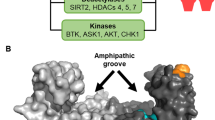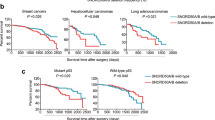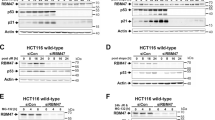Abstract
Inactivation of the p53 tumor suppressor pathway is a critical step in human tumorigenesis. In addition to mutations, p53 can be functionally silenced through its increased degradation, inhibition of its transcriptional activity and/or its inappropriate subcellular localization. Using a proteomic approach, we have found that members of the Ras network of proteins, Ras-GTPase activating protein-SH3-domain-binding proteins 1 and 2 (G3BP1 and 2), bind to p53 in vitro and in vivo. Our data show that expression of G3BPs leads to the redistribution of p53 from the nucleus to the cytoplasm. The G3BP2 isoform additionally associated with murine double minute 2 (MDM2), a negative regulator of p53. G3BP2 expression resulted in significant reduction in MDM2-mediated p53 ubiquitylation and degradation. Interestingly, MDM2 was also stabilized in G3BP2-expressing cells and its ability to ubiquitylate itself was compromised. Accordingly, short hairpin RNA (shRNA)-mediated knockdown of G3BP2 caused a reduction in MDM2 protein levels. Furthermore, expression of shRNA targeting either G3BP1 or G3BP2 in human cancer cell lines resulted in marked upregulation of p53 levels and activity. Our results suggest that both G3BP isoforms may act as negative regulators of p53.
This is a preview of subscription content, access via your institution
Access options
Subscribe to this journal
Receive 50 print issues and online access
$259.00 per year
only $5.18 per issue
Buy this article
- Purchase on Springer Link
- Instant access to full article PDF
Prices may be subject to local taxes which are calculated during checkout



Similar content being viewed by others
References
Atlas R, Behar L, Elliott E, Ginzburg I . (2004). The insulin-like growth factor mRNA binding-protein IMP-1 and the Ras-regulatory protein G3BP associate with tau mRNA and HuD protein in differentiated P19 neuronal cells. J Neurochem 89: 613–626.
Barnes CJ, Li F, Mandal M, Yang Z, Sahin AA, Kumar R . (2002). Heregulin induces expression, ATPase activity, and nuclear localization of G3BP, a Ras signaling component, in human breast tumors. Cancer Res 62: 1251–1255.
French J, Stirling R, Walsh M, Kennedy HD . (2002). The expression of Ras-GTPase activating protein SH3 domain-binding proteins, G3BPs, in human breast cancers. Histochem J 34: 223–231.
Gallouzi IE, Parker F, Chebli K, Maurier F, Labourier E, Barlat I et al. (1998). A novel phosphorylation-dependent RNase activity of GAP-SH3 binding protein: a potential link between signal transduction and RNA stability. Mol Cell Biol 18: 3956–3965.
Geyer RK, Yu ZK, Maki CG . (2000). The MDM2 RING-finger domain is required to promote p53 nuclear export. Nat Cell Biol 2: 569–573.
Gu J, Kawai H, Nie L, Kitao H, Wiederschain D, Jochemsen AG et al. (2002). Mutual dependence of MDM2 and MDMX in their functional inactivation of p53. J Biol Chem 277: 19251–19254.
Gu J, Nie L, Kawai H, Yuan ZM . (2001). Subcellular distribution of p53 and p73 are differentially regulated by MDM2. Cancer Res 61: 6703–6707.
Guitard E, Parker F, Millon R, Abecassis J, Tocque B . (2001). G3BP is overexpressed in human tumors and promotes S phase entry. Cancer Lett 162: 213–221.
Huang Y, Wernyj RP, Norton DD, Precht P, Seminario MC, Wange RL . (2005). Modulation of specific protein expression levels by PTEN: identification of AKAP121, DHFR, G3BP, Rap1, and RCC1 as potential targets of PTEN. Oncogene 24: 3819–3829.
Kawai H, Wiederschain D, Kitao H, Stuart J, Tsai KK, Yuan ZM . (2003). DNA damage-induced MDMX degradation is mediated by MDM2. J Biol Chem 278: 45946–45953.
Kedersha N, Stoecklin G, Ayodele M, Yacono P, Lykke-Andersen J, Fitzler MJ et al. (2005). Stress granules and processing bodies are dynamically linked sites of mRNP remodeling. J Cell Biol 169: 871–884.
Kennedy D, French J, Guitard E, Ru K, Tocque B, Mattick J . (2001). Characterization of G3BPs: tissue specific expression, chromosomal localisation and rasGAP(120) binding studies. J Cell Biochem 84: 173–187.
Levine AJ . (1997). p53, the cellular gatekeeper for growth and division. Cell 88: 323–331.
Li M, Chen D, Shiloh A, Luo J, Nikolaev AY, Qin J et al. (2002). Deubiquitination of p53 by HAUSP is an important pathway for p53 stabilization. Nature 416: 648–653.
Liu Y, Zheng J, Fang W, You J, Wang J, Cui X et al. (2001). Identification of metastasis associated gene G3BP by differential display in human cancer cell sublines with different metastatic potentials G3BP as highly expressed in non-metastatic. Chin Med J (Engl) 114: 35–38.
Molinari AM, Bontempo P, Schiavone EM, Tortora V, Verdicchio MA, Napolitano M et al. (2000). Estradiol induces functional inactivation of p53 by intracellular redistribution. Cancer Res 60: 2594–2597.
Pazman C, Mayes CA, Fanto M, Haynes SR, Mlodzik M . (2000). Rasputin, the Drosophila homologue of the RasGAP SH3 binding protein, functions in ras- and Rho-mediated signaling. Development 127: 1715–1725.
Soncini C, Berdo I, Draetta G . (2001). Ras-GAP SH3 domain binding protein (G3BP) is a modulator of USP10, a novel human ubiquitin specific protease. Oncogene 20: 3869–3879.
Tocque B, Delumeau I, Parker F, Maurier F, Multon MC, Schweighoffer F . (1997). Ras-GTPase activating protein (GAP): a putative effector for Ras. Cell Signal 9: 153–158.
Tourriere H, Chebli K, Zekri L, Courselaud B, Blanchard JM, Bertrand E et al. (2003). The RasGAP-associated endoribonuclease G3BP assembles stress granules. J Cell Biol 160: 823–831.
Vogelstein B, Lane D, Levine AJ . (2000). Surfing the p53 network. Nature 408: 307–310.
Wiederschain D, Gu J, Yuan ZM . (2001). Evidence for a distinct inhibitory factor in the regulation of p53 functional activity. J Biol Chem 276: 27999–28005.
Zekri L, Chebli K, Tourriere H, Nielsen FC, Hansen TV, Rami A et al. (2005). Control of fetal growth and neonatal survival by the RasGAP-associated endoribonuclease G3BP. Mol Cell Biol 25: 8703–8716.
Acknowledgements
We thank Dr Bert Vogelstein for his generous gift of cells used in this study, and Dr Yang Shi for the pBS/U6 plasmid. We also thank the Biological Analysis Facility Care (NIEHS 5P30ES00002) for their expertise. This work was funded by the National Institutes of Health RO1CA85679-02 to ZMY. DW is supported by the Ruth L Kirschstein National Research Service Award (CA009078). MMK is supported by National Institutes of Health T32ES007155.
Author information
Authors and Affiliations
Corresponding author
Rights and permissions
About this article
Cite this article
Kim, M., Wiederschain, D., Kennedy, D. et al. Modulation of p53 and MDM2 activity by novel interaction with Ras-GAP binding proteins (G3BP). Oncogene 26, 4209–4215 (2007). https://doi.org/10.1038/sj.onc.1210212
Received:
Revised:
Accepted:
Published:
Issue Date:
DOI: https://doi.org/10.1038/sj.onc.1210212
Keywords
This article is cited by
-
Effect of P53 nuclear localization mediated by G3BP1 on ferroptosis in acute liver failure
Apoptosis (2023)
-
RIOK1 mediates p53 degradation and radioresistance in colorectal cancer through phosphorylation of G3BP2
Oncogene (2022)
-
G3BP1 interacts with YWHAZ to regulate chemoresistance and predict adjuvant chemotherapy benefit in gastric cancer
British Journal of Cancer (2021)
-
O-GlcNAcylation of PFKFB3 is required for tumor cell proliferation under hypoxia
Oncogenesis (2020)
-
The interaction of YBX1 with G3BP1 promotes renal cell carcinoma cell metastasis via YBX1/G3BP1-SPP1- NF-κB signaling axis
Journal of Experimental & Clinical Cancer Research (2019)



